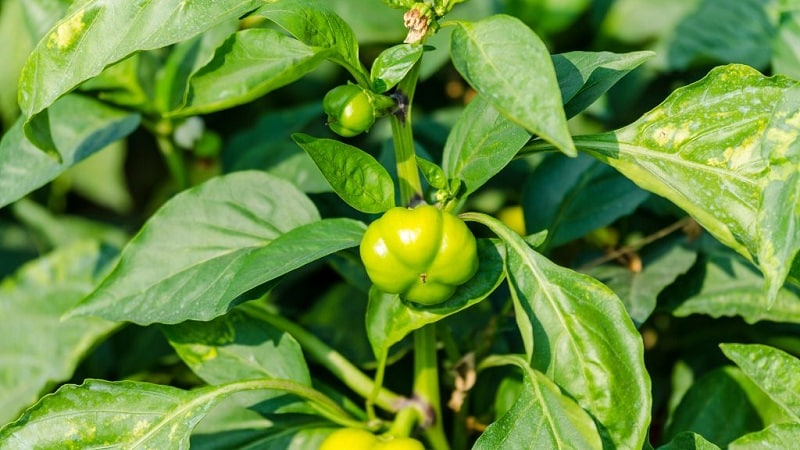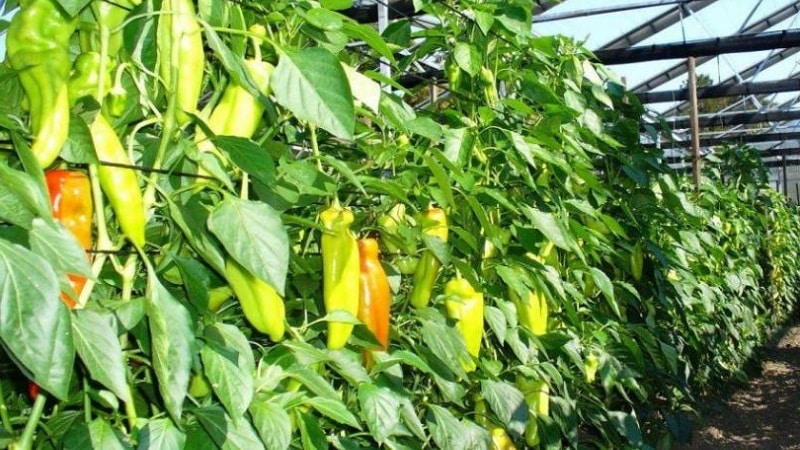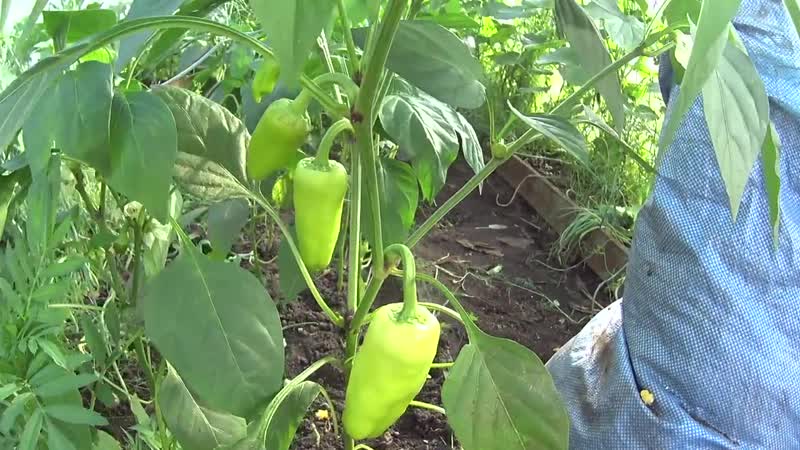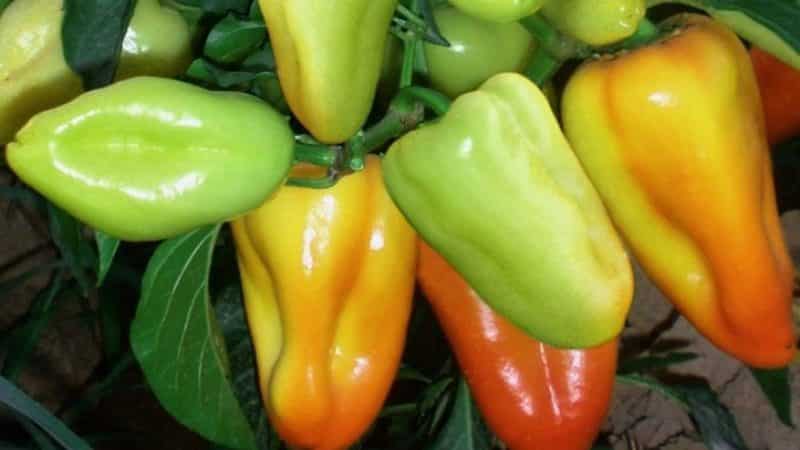Why peppers don’t turn red and what to do to speed up ripening
Pepper pods on bushes are not always pleased with their rapid ripening. Despite the fact that the time has come to harvest, the vegetables are still hanging in the stage of incomplete ripeness. In order for tasty, bright and juicy fruits to appear on the table, you need to pay attention on varietal properties and features of crop care. Today we’ll tell you why peppers don’t turn red and how to speed up their ripening.
Pepper ripening stages
Considering harvesting pepper to be a simple matter, many people pick the fruits at the stage of incomplete ripeness. This affects the taste and further storage and preparation of vegetables. Agrotechnicians distinguish 2 types of maturity:
- Technical (cleaning room). It occurs 40-45 days after the formation of the ovaries, when the pepper has not yet fully acquired its characteristic varietal properties, but is already suitable for consumption and processing.
- Biological (natural). It begins when the seeds ripen and the crop acquires a bright varietal shade.

20-30 days pass between biological and technical maturity. During this time, vegetables accumulate the maximum amount of nutrients and vitamins and are saturated with sugars and microelements.
Important! Fully ripened bell peppers have the best flavor and distinct aroma. Therefore, it is recommended to collect them in this phase.
The heat of hot pepper can be adjusted.A technically ripe crop still contains a small amount of pungent substance, so it is collected for preparing mild dishes and marinades. If you plan to store the harvested crop for a long time or process it into a powdered state, it must be picked from the bushes at the stage of full biological maturity.
Reasons why peppers don't turn red
Every summer resident dreams of collecting large, fleshy and bright fruits on his plot. However, why, having reached a large size, do the peppers never ripen? There may be several reasons.
Varietal features
One of the common mistakes of inexperienced gardeners is trying to grow a high-quality crop from seeds collected from store-bought vegetables.. Beautiful and large fruits, which can be bought all year round in supermarkets, are imported from China, Turkey, Egypt or the southern regions of Russia. The climatic conditions of these regions are very different from the middle zone, where crops lack heat and sunlight. Therefore, these varieties either do not ripen completely or ripen several weeks later than more adapted ones.
Reference. Some species should not turn red or yellow. Depending on the varietal properties, the pepper can have a shade from light green to bright purple and even chocolate. On the package with seeds, the instructions indicate the ripening time and color of vegetables at the stage of biological ripeness.
Unfavourable conditions

Unsuitable growing conditions for pepper also affect its ripening and coloring:
- Temperature regime. When the thermometer drops to 12°C, the growth and development of pepper stops, and when it rises to 35°C, the bushes quickly dry out. The optimal range is from 18 to 30°C.
- Lack of lighting. Peppers require at least 12 hours of exposure to sunlight. Ripening and fruiting are also impaired when daylight hours are too long - more than 14 hours.
- Violation of irrigation technique. Cold, unsettled water is absolutely unsuitable for this culture.
- Thickened planting. Fruits on bushes blocking each other ripen poorly and do not turn red for a long time due to lack of nutrients.
The method of watering affects the development of bushes. Water should not get on the stems and leaves; it should be carefully poured right to the root. The soil should not be overly moist - this will lead to the development of fungus and bacterial diseases.
Agrotechnical errors
Beginner gardeners make mistakes even at the stage of planting seeds. They can be added to the soil when temperature fluctuations between day and night are not expected.. The weather should be consistently warm and the soil should warm up sufficiently.
The soil for peppers should be light, fertile and nutritious. The beds are fertilized with organic compounds and dolomite flour is added. This allows you to normalize acidity. Neutral or slightly acidic soil is suitable for timely ripening of vegetables.
One of the reasons why peppers do not ripen is incorrect fertilizing technique. The crop does not tolerate excess nitrogen: instead of bearing fruit, the green mass actively develops and the bush grows strongly. A lack of potassium has a negative effect on the plant, without which redness may not occur at all. This problem is common in areas with a high content of peat or sand.
Attention! Compositions containing nitrogen cannot be applied during fruiting and flowering of the crop.
Pepper needs calcium fertilization at any stage of ripening.Its deficiency is well compensated with the help of wood ash. At the moment of fruit formation, phosphorus is added, and calcium nitrate is added 2-3 times throughout the growing season, which prevents rotting.
A plant with too many ovaries also does not produce a good harvest. For this reason, the fruits do not have time to develop to large sizes and the desired color. Therefore, it is recommended to remove the first inflorescence at the branching point of the stems. Only one, the strongest bud is left in the internodes, otherwise, due to the growth of branches, the bush will not have enough strength to ripen.
Reference. A large number of ovaries on one bush (more than 25) slows down biological maturity, and the pepper grows small.

What to do to make the pepper turn red faster on the bush
Experienced gardeners know several tricks to speed up the reddening of peppers. These tricks will help extend the bell pepper harvest until the very first frost:
- construct an additional shelter from non-woven materials or agrofibre (used for young seedlings and adult crops with the onset of autumn cold weather);
- use very warm, almost hot water (up to 60°C) for irrigation, pour strictly under the root;
- carry out foliar feeding once every 10-12 days, spraying the bushes with phosphorus-potassium compounds or a solution of wood ash;
- remove some of the leaves; peppers do not need them to ripen.
It is important to protect bell peppers from excess moisture during periods of heavy rainfall by constructing a shelter of low arcs and film.
Reference. Bell and bitter peppers respond well to the addition of yeast solutions. They are made from fresh bread, crackers and even moldy remains of rolls.The yeast fungus saturates the soil with useful microelements and vitamins and stimulates the ripening of fruits.
Unlike bell peppers, hot peppers cannot ripen once they are picked from the bush. Therefore, a trick is used for it: if the peppercorns have not yet turned red enough and are ripening too slowly, the bush is dug up and hung upside down. The harvest ripens faster and is very hot.
Nuances for greenhouses
Since pepper is a heat-loving crop, it is recommended to close the windows and doors in the greenhouse at night. This will prevent freezing and protect against drafts. For additional heating, you can install heaters or place plastic bottles of hot water between the beds.
Long shoots during the active growing season need to be pruned in a timely manner to improve illumination and stimulate reddening of the fruits.
Important! Unhealthy or weakened-looking bushes should not be pinched or pinched, otherwise the plant will completely die.
Light is added to the greenhouse using ultraviolet lamps. Even if there is enough sunlight, the blue spectrum will not be superfluous for peppers.
For open ground

In open areas, it is more difficult to protect the crop from hypothermia, so it requires shelter and heating similar to a greenhouse (bottles between the beds or stones heated in the oven).
A prerequisite for rapid maturation is regular shaping.. At the end of the summer period, all flowers are removed, and shoots that grow too large are plucked during the entire growing season.
Small peppercorns are also removed from the bush at the beginning of autumn, as they will no longer be able to reach biological maturity.The remaining fruits can be removed from the bush unripe in the event of early cold weather and constant rainy weather. In conditions of increased dampness and coolness, the fruits quickly rot.
Advice from experienced summer residents
Most experienced summer residents agree that peppers do not necessarily need ripen completely on the beds. Shiny, weighty and juicy vegetables already contain a lot of vitamins, and they can even ripen on the windowsill.
After the first harvest is harvested, the bushes will continue to bear fruit under favorable conditions. This process can be further stimulated by spreading banana peels on the soil under the plant.
If there is no well-lit place on the site and the crop has to be planted in the shade, you can add light using reflective screens.
Reference. You can speed up reddening by placing ripe apples and tomatoes next to the bushes under covering material. The process of ripening vegetables is accompanied by the release of ethylene, which will affect the peppers.
Conclusion
Obtaining a high-quality harvest is the result of constant care of plants, compliance with the rules of planting, watering and fertilizing. If the variety is chosen correctly and all growing conditions are met, the pepper will certainly delight you with tasty and timely ripened fruits.